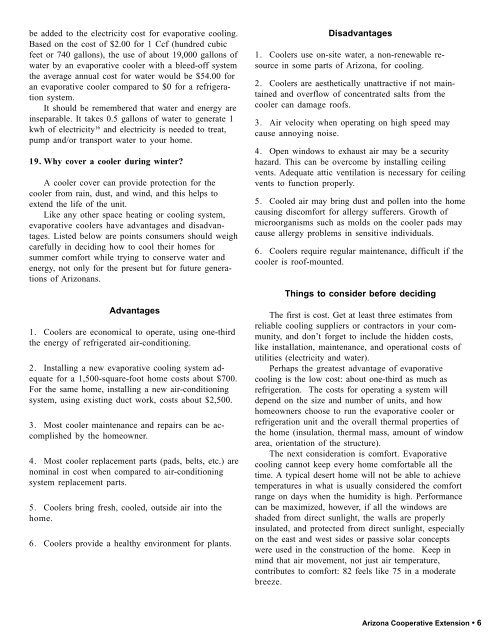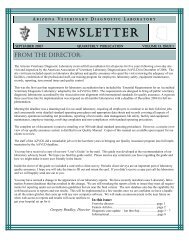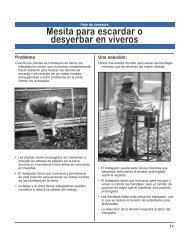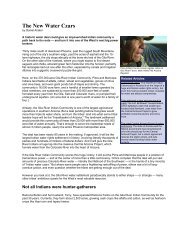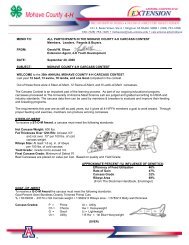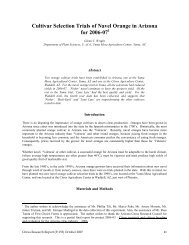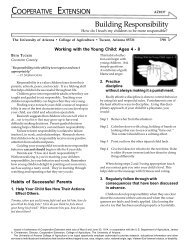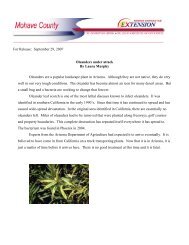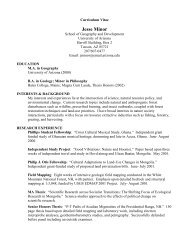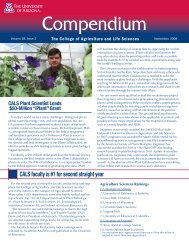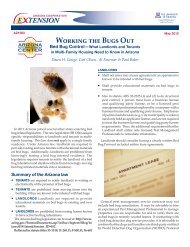Evaporative cooler water use - University of Arizona
Evaporative cooler water use - University of Arizona
Evaporative cooler water use - University of Arizona
You also want an ePaper? Increase the reach of your titles
YUMPU automatically turns print PDFs into web optimized ePapers that Google loves.
e added to the electricity cost for evaporative cooling.<br />
Based on the cost <strong>of</strong> $2.00 for 1 Ccf (hundred cubic<br />
feet or 740 gallons), the <strong>use</strong> <strong>of</strong> about 19,000 gallons <strong>of</strong><br />
<strong>water</strong> by an evaporative <strong>cooler</strong> with a bleed-<strong>of</strong>f system<br />
the average annual cost for <strong>water</strong> would be $54.00 for<br />
an evaporative <strong>cooler</strong> compared to $0 for a refrigeration<br />
system.<br />
It should be remembered that <strong>water</strong> and energy are<br />
inseparable. It takes 0.5 gallons <strong>of</strong> <strong>water</strong> to generate 1<br />
kwh <strong>of</strong> electricity 16 and electricity is needed to treat,<br />
pump and/or transport <strong>water</strong> to your home.<br />
19. Why cover a <strong>cooler</strong> during winter?<br />
A <strong>cooler</strong> cover can provide protection for the<br />
<strong>cooler</strong> from rain, dust, and wind, and this helps to<br />
extend the life <strong>of</strong> the unit.<br />
Like any other space heating or cooling system,<br />
evaporative <strong>cooler</strong>s have advantages and disadvantages.<br />
Listed below are points consumers should weigh<br />
carefully in deciding how to cool their homes for<br />
summer comfort while trying to conserve <strong>water</strong> and<br />
energy, not only for the present but for future generations<br />
<strong>of</strong> <strong>Arizona</strong>ns.<br />
Advantages<br />
1. Coolers are economical to operate, using one-third<br />
the energy <strong>of</strong> refrigerated air-conditioning.<br />
2. Installing a new evaporative cooling system adequate<br />
for a 1,500-square-foot home costs about $700.<br />
For the same home, installing a new air-conditioning<br />
system, using existing duct work, costs about $2,500.<br />
3. Most <strong>cooler</strong> maintenance and repairs can be accomplished<br />
by the homeowner.<br />
4. Most <strong>cooler</strong> replacement parts (pads, belts, etc.) are<br />
nominal in cost when compared to air-conditioning<br />
system replacement parts.<br />
5. Coolers bring fresh, cooled, outside air into the<br />
home.<br />
6. Coolers provide a healthy environment for plants.<br />
Disadvantages<br />
1. Coolers <strong>use</strong> on-site <strong>water</strong>, a non-renewable resource<br />
in some parts <strong>of</strong> <strong>Arizona</strong>, for cooling.<br />
2. Coolers are aesthetically unattractive if not maintained<br />
and overflow <strong>of</strong> concentrated salts from the<br />
<strong>cooler</strong> can damage ro<strong>of</strong>s.<br />
3. Air velocity when operating on high speed may<br />
ca<strong>use</strong> annoying noise.<br />
4. Open windows to exhaust air may be a security<br />
hazard. This can be overcome by installing ceiling<br />
vents. Adequate attic ventilation is necessary for ceiling<br />
vents to function properly.<br />
5. Cooled air may bring dust and pollen into the home<br />
causing discomfort for allergy sufferers. Growth <strong>of</strong><br />
microorganisms such as molds on the <strong>cooler</strong> pads may<br />
ca<strong>use</strong> allergy problems in sensitive individuals.<br />
6. Coolers require regular maintenance, difficult if the<br />
<strong>cooler</strong> is ro<strong>of</strong>-mounted.<br />
Things to consider before deciding<br />
The first is cost. Get at least three estimates from<br />
reliable cooling suppliers or contractors in your community,<br />
and don’t forget to include the hidden costs,<br />
like installation, maintenance, and operational costs <strong>of</strong><br />
utilities (electricity and <strong>water</strong>).<br />
Perhaps the greatest advantage <strong>of</strong> evaporative<br />
cooling is the low cost: about one-third as much as<br />
refrigeration. The costs for operating a system will<br />
depend on the size and number <strong>of</strong> units, and how<br />
homeowners choose to run the evaporative <strong>cooler</strong> or<br />
refrigeration unit and the overall thermal properties <strong>of</strong><br />
the home (insulation, thermal mass, amount <strong>of</strong> window<br />
area, orientation <strong>of</strong> the structure).<br />
The next consideration is comfort. <strong>Evaporative</strong><br />
cooling cannot keep every home comfortable all the<br />
time. A typical desert home will not be able to achieve<br />
temperatures in what is usually considered the comfort<br />
range on days when the humidity is high. Performance<br />
can be maximized, however, if all the windows are<br />
shaded from direct sunlight, the walls are properly<br />
insulated, and protected from direct sunlight, especially<br />
on the east and west sides or passive solar concepts<br />
were <strong>use</strong>d in the construction <strong>of</strong> the home. Keep in<br />
mind that air movement, not just air temperature,<br />
contributes to comfort: 82 feels like 75 in a moderate<br />
breeze.<br />
<strong>Arizona</strong> Cooperative Extension • 6


